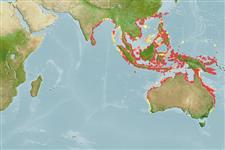Common names from other countries
>
Ovalentaria/misc (Various families in series Ovalentaria) >
Pomacentridae (Damselfishes) > Glyphisodontinae
Etymology: Abudefduf: Arabic, abu = father; this fish is the leader of the reef against other species (Ref. 45335).
More on author: Bloch.
Environment: milieu / climate zone / depth range / distribution range
Ecología
marino asociado a arrecife; no migratorio; rango de profundidad 1 - 6 m (Ref. 7247). Tropical; 25°N - 35°S, 79°E - 155°E (Ref. 56015)
Western Pacific: eastern Indian Ocean to Japan and Australia (Ref. 559). Not in Red Sea (Ref. 84159).
Tamaño / Peso / Age
Maturity: Lm ? range ? - ? cm
Max length : 17.0 cm TL macho / no sexado; (Ref. 9710)
Short description
Claves de identificación | Morfología | Morfometría
Espinas dorsales (total) : 8; Radios blandos dorsales (total) : 13 - 15; Espinas anales: 2; Radios blandos anales: 13 - 14.
Adults occur singly or in small groups in inshore reef and lagoon environments. Feed on algae, gastropods, and small crabs. Highly territorial (Ref. 9710). Oviparous, distinct pairing during breeding (Ref. 205). Eggs are demersal and adhere to the substrate (Ref. 205). Males guard and aerate the eggs (Ref. 205).
Life cycle and mating behavior
Maturities | Reproducción | Spawnings | Egg(s) | Fecundities | Larva
Oviparous, distinct pairing during breeding (Ref. 205). Eggs are demersal and adhere to the substrate (Ref. 205). Males guard and aerate the eggs (Ref. 205).
Allen, G.R., 1991. Damselfishes of the world. Mergus Publishers, Melle, Germany. 271 p. (Ref. 7247)
IUCN Red List Status (Ref. 130435)
CITES (Ref. 128078)
Not Evaluated
Threat to humans
Harmless
Human uses
Pesquerías: escaso valor comercial
Herramientas
Special reports
Download XML
Fuentes de Internet
Estimates based on models
Preferred temperature (Ref.
115969): 25 - 29.3, mean 28.7 (based on 2070 cells).
Phylogenetic diversity index (Ref.
82804): PD
50 = 0.5000 [Uniqueness, from 0.5 = low to 2.0 = high].
Bayesian length-weight: a=0.02188 (0.00932 - 0.05134), b=3.08 (2.89 - 3.27), in cm Total Length, based on LWR estimates for this Genus-body shape (Ref.
93245).
Nivel trófico (Ref.
69278): 3.1 ±0.46 se; based on food items.
Resiliencia (Ref.
120179): Medio, población duplicada en un tiempo mínimo de 1.4-4.4 años (Preliminary K or Fecundity.).
Fishing Vulnerability (Ref.
59153): Low vulnerability (10 of 100).
